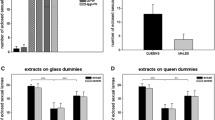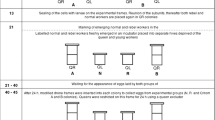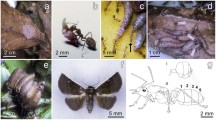Summary
Simulation of the way workers attack big larvae in spring has produced evidence that the mechanical component of this alone is sufficient to induce earlier metamorphosis with a consequent switch from queen to worker formation.
As the jaws are used and the mandibular glands contain a proteinase normally used in the external digestion of prey, it is highly probable that this, too, is involved in attack. It is shown that the mandibular gland material causes major damage to the cuticle of the larva and may cause it to lose water.
Like queens, workers contain fatty acids in their heads and the chain length frequency is quite similar. In both castes the commonest is oleic acid. Applied topically this enters the larva, reduces its growth rate and damages its water-proofing. Water-impermeability can be restored by workers.
These fatty acids, however, are not very abundant inMyrmica. They are present in the pharyngeal gland which is used to feed larvae and is very palatable. There is no evidence that it is used topically as a poison though it is certainly able to pass straight in through the larval cuticle; if implanted it is harmless.
The mandibular glands of queens and workers have been removed surgically. Workers are still able to rear larvae quite well and are susceptible to the influence of queens, but to a lesser degree than normal. This is either because they are undernourished, as the gland is their main oral source of proteinase, or because they need the mandibular chemicals to raise the intensity of their group aggression.
the pharyngeal glands of queens and workers have also been removed. This destroys much of the worker drive towards larvae and leads to their gradual emaciation, probably because some dligestion and absorption takes place there. Larvae lose weight, too, and so the influence of queens on broodrearing cannot be tested.
Résumé
En simulant la manière dont les ouvrières attaquent au printemps les grandes larves, on montre que les stimulations mécaniques seules suffisent à induire prématurément la métamorphose avec production d'ouvrières ou bien de reine.
Puisque les mandibules sont utilisées et que les glandes mandibulaires contiennent une protéinase, utilisée normalement pour la digestion externe des proies, il est hautement probable que cela, aussi, intervienne dans l'attaque. Il est montré que la subtance des glandes mandibulaires occasionne les principaux dégâts à la cuticule de la larve et peut induire des pertes d'eau.
Comme celle des reines, la tête des ouvrières contient des acides gras et leur répartition en fonction de la longueur des chaînes est rigoureusement identique. Dans les deux castes, le plus commun est l'acide oléique. Appliqué localement, celui-ci pénètre dans la larve, réduit son taux de croissance et perturbe son imperméabilité à l'eau. L'imperméabilité à l'eau peut être rétablie par les ouvrières.
Cependant, ces acides gras ne sont pas très abondants chezMyrmica. Ils sont présents dans la glande pharyngienne qui est utilisée dans le nourrissement des larves et est d'un goût agréable. Il n'y a aucune preuve qu'elle soit utilisée localement comme poison, bien qu'elle soit certainement capable de traverser directement la cuticule larvaire; implantée, elle est inoffensive.
L'ablation chirurgicale des glandes mandibulaires de reines et d'ouvrières a été faite. Les ouvrières sont encore tout à fait capables d'élever des larves et sont sensibles à l'influence des reines, mais à un degré moindre que normal. Cela est dû soit à une sous-alimentation, car la glande est leur principale source orale de protéinase, soit parce qu'elles ont besoin des substances mandibulaires pour augmenter l'intensité de l'agression de leur groupe.
Les glandes pharyngiennes de reines et d'ouvrières ont aussi, été enlevées. Cela annihile beaucoup de l'attirance des ouvrières vers les larves et mène à leur déssèchement progressif probablement parce qu'il y a alors une certaine digestion et absorption. Les larves perdent aussi du poids, et ainsi l'influence des reines sur l'élevage du couvain ne peut pas être étudiée.
Similar content being viewed by others
References
Brian (M. V.), 1955. — Studies of caste differentiation inMyrmica rubra L. 2. The growth of workers and intercastes.Ins. Soc., 2, 1–34.—Brian (M. V.), 1956. Studies of caste differentiation inMyrmica rubra L. 4. Controlled larval nutrition.Ins. Soc., 3, 369–394.—Brian (M. V.), 1965. Caste differentiation in social insects.Symph. Zool. Soc. London, 14, 13–38.—Brian (M. V.), 1967. Regulation of sexual production in an ant society. Proceedings of Symposium No. 173 of the Centre national de Recherches scientifique, 1967, Paris,L'effet de groupe chez les animaux, 61–76.—Brian (M. V.), 1970. Communication between queens and larvae in the antMyrmica. Anim. Behav., 18, 467–472.—Brian (M. V.), 1973a. Feeding and growth in the antMyrmica. J. Anim. Ecol., 42, 37–53.—Brian (M. V.), 1973b (in press). Queen recognition by brood rearing workers of the antMyrmica rubra L.Anim. Behav.
Brian (M. V.) andHibble (J.), 1963. — Larval size and the influence of the queen on growth inMyrmica.Ins. Soc. 10, 71–81.
Brian (M. V.) andBlum (M. S.), 1969. — The influence ofMyrmica queen head extracts on larval growth.J. Insect. Physiol., 15, 2213–2223.
Carr (C. A. H.), 1962. — Further studies on the influence of the queen in ants of the genusMyrmica.Ins. Soc., 9, 197–211.
Crewe (R. M.) andBlum (M. S.), 1970a. — Identification of the alert pheromones of the antMyrmica brevinodis.J. Insect Physiol., 16, 141–146.—Crewe (R. M.) andBlum (M. S.), 1970b. Alarm pheromones in the genusMyrmica (Hymenoptera: Formicidae), their composition and species specificity.Z. vergl. Physiol., 70, 363–373.
Delage (B.), 1968. — Recherches sur les fourmis moissonneuses du bassin aquitain: éthologie. Physiologie de l'alimentation.Ann. Sci. Nat. Zool., 10, 197–266.
Gurr (E.) 1958. —Methods of analytical histology and histo-chemistry. Leonard Hill (Books) Ltd., London, 327 p.
Passera (L.), 1969. — Biologie de la reproduction chezPlagiolepis pygmaea Latreille et ses deux parasites sociauxPlagiolepis grassei Le Masne et Passera etPlagiolepis xene Starke (Hymenoptera, Formicidae).Ann. Sci. Nat. Zool., 11, 327–481.
Pickford (G. E.) andDorris (F.), 1934. —Micro-methods for the detection of proteases and amylases.Science, 80, 317–319.
Regnier (F. E.) andWilson (E. O.), 1968) — The alarm-defence system of the antAcanthomyops claviger.J. Insect Physiol., 14, 955–970.
Rockstein (M.) (ed.), 1964. —The physiology of insecta, vol. III. Academic Press, New York and London, 692 p.
Schmidt (G. H.), 1969. — Photoaktive Substanzen in verscheiden pradispoierten Eiern und Junglarven vonFormica polyctena Foerst.Proceeding of 6th Congress of International Union for the Study of Social Insects 1969, Bern, 257–261.
Schneirla (T. C.), 1971. —Army ants: a study in social organisation. W. H. Freeman and Co., San Francisco, 349 p.
Tricot (M. C.), Pasteels (J. M.) andTursch (B.), 1972. — Phéromones stimulant et inhibitant l'agressivité chezMyrmica rubra.J. Insect. Physiol., 18, 499–509.
Wallis (D. I.), 1962. — Aggressive behaviour in the ant,Formica fusca.Anim. Behav., 10, 267–274.
Way (M. J.), 1954. — Studies on the association of the antOecophylla longinoda (Latr.) (Formicidae) with the scale insectSaissetia zanzibarensis Williams (Coccidae).Bull. ent. Res. (Entomol.), 45, 113–114.
Wilson (E. O.), Durlach (N. I.) andRoth (L. M.), 1958. — Chemical releasers of necrophoric behaviour in ants.Psyche, 65, 108–114.
Author information
Authors and Affiliations
Rights and permissions
About this article
Cite this article
Brian, M.V. Caste control through worker attack in the antMyrmica . Ins. Soc 20, 87–102 (1973). https://doi.org/10.1007/BF02223340
Issue Date:
DOI: https://doi.org/10.1007/BF02223340




